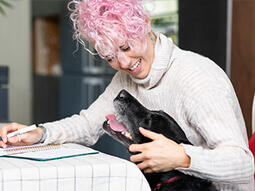
While it’s not common, sometimes dogs can suffer seizures. There are many potential causes, from ingesting something toxic to having dog epilepsy. This guide will help you understand more about seizures in dogs, and what to do if your dog has a seizure.
Epilepsy in dogs also known as ‘fitting’ is the result of abnormal electrical activity in their brain, resulting in a loss of control of their body. There are four key types of seizures in dogs which can be caused by a number of things from liver disease to the ingestion of a toxin.
Dog seizures can be a very frightening thing to witness for owners, but it’s important to know how to react to them and when to contact your vet. That’s why we’ve created this guide to tell you all about epilepsy in dogs, the possible triggers and the myths surrounding them, keep reading to find out more.
What to look out for with dog seizures
Simply put, a dog seizure is caused by abnormal bursts of electrical activity in your pet’s brain which results in twitching, shaking, and sometimes loss of consciousness.
Even if you don’t know what to expect, it will probably be quite clear if your dog is having a seizure. Your dog will begin by behaving very unusually, and the seizure itself can seem quite dramatic. The most important thing you can do is to remain calm and decide on the next step to take.

Before the seizure
Although it can be hard to predict when a seizure will happen, there are a few ‘pre-seizure’ symptoms you can watch out for. Shortly before your dog has a seizure, they may exhibit:
- Unusual behaviour such as seeking attention or appearing nervous
- Restlessness
- Salivating
- Whining
During the seizure
The main part of your dog’s seizure can last from a few seconds up to five minutes, or in some cases, longer. These symptoms occur in the middle of the seizure. There is nothing that can be done to prevent the seizure, but you can try to keep your pet safe and comfortable. During a seizure, your dog may experience:
- Loss of consciousness
- Muscle spasms, particularly in the legs
- Appearance of ‘treading water’
- Salivation
- Urination, or loss of bowel control
- Foaming at the mouth
Dog seizure triggers
If your dog has repeated seizures, they may be diagnosed with epilepsy. Dog epilepsy is an inherited disorder, and it’s the most common cause of repeated seizures. The exact cause of dog epilepsy is unknown, but it’s likely to be one of the first things your vet investigates if there is no other obvious cause. Some underlying conditions can also cause seizures in dogs, such as:
- Liver disease
- A brain tumour
- Kidney failure
- Very low or high blood sugar
Dog seizure triggers for one off episodes:
- Physical trauma
- Ingestion of a toxin
- A stroke
It’s not unheard of for a dog to have one seizure, then never have one again. Sometimes you won’t be able to pinpoint the cause. However, whether your dog has had one or multiple seizures, it’s vital that they get checked out by the vet.
Types of seizures in dogs
There are four different categories that seizures in dogs fall into:
This type of seizure in dogs is due to abnormal electrical activity throughout the whole of the brain and will display as a loss of consciousness with convulsions present too. A generalised seizure will usually last between a few seconds and a few minutes.
A focal seizure is where abnormal activity is only located in a part of the brain. There will be unusual movements in one limb or on one side of the body and it will last for around a couple of seconds. With this type of seizure in dogs it may also progress to a generalised one in some cases.
Psychomotor seizures are characterised as strange behaviour lasting a couple of minutes, such as attacking things that aren’t there or chasing their tail. Sometimes, this type is hard to differentiate from just odd behaviour, but with psychomotor seizures, your dog will always do the same thing every time.
Types of seizures in dogs that come from an unknown cause are known as idiopathic epilepsy. These are most common in Border Collies, Labradors, Beagles and German Shepherds aged between 6 months and 6 years old.
Dealing with a dog seizure
If your dog has a seizure, the first thing to do is to stay calm – that way, you’ll be far more helpful to your pet. If your dog is near something they could hit their head on, such as the stairs, gently move them.
Try to keep your dog cool, perhaps by turning a fan on. If you want to help comfort them, try talking to your dog calmly. As soon as the seizure ends, call a vet.
If the seizure doesn’t end within five minutes, or your dog remains unconscious and has a series of seizures, don’t wait for them to end – call the vet immediately. Your vet will be able to tell you what to do. They may want you to bring your dog in, so they can administer medication and run tests.
Dog seizure myths
Despite popular belief, dogs are not at risk of swallowing their tongue during a seizure. Don’t put your fingers in their mouth during a seizure, as this can result in an inadvertently nasty bite.
Most dog seizures are not painful. Injury only tends to occur if your dog hits themselves on something during their seizure, so it’s a good idea to keep an eye on their surroundings.
That’s our guide to dog seizures and epilepsy, hopefully now you know what to do, just in case! Want to find out more about dog illness symptoms to watch out for? Read our guide to dog depression, next.












